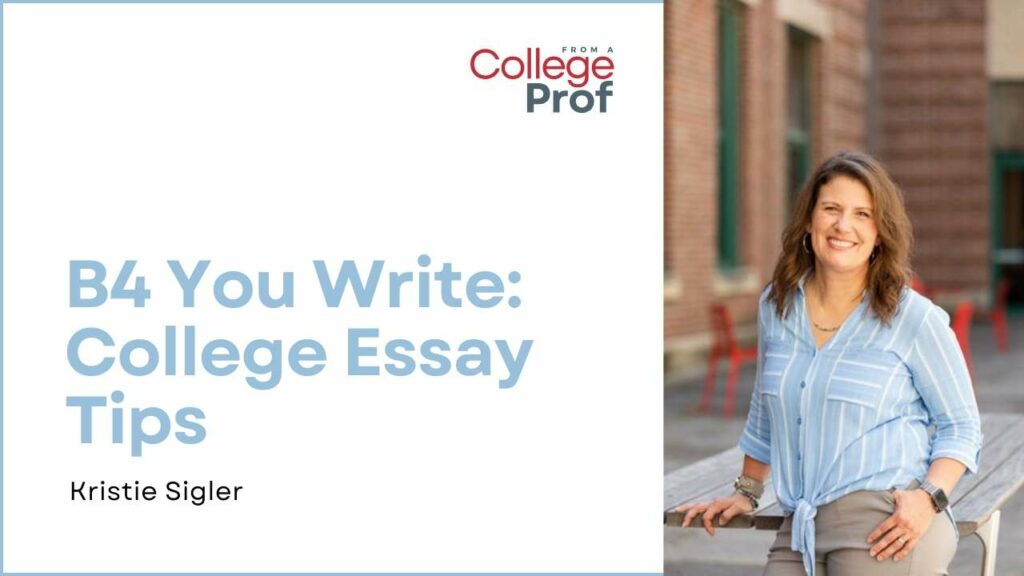College Admissions Essay Format: 19 Expert Tips

Get expert essay writing advice from an admissions insider and 2 communication professors who have read thousands of essays. We share what admissions offices are looking for in college essays, how to format your essay and what you can do to make your essay stand out.
Writing a college essay for admissions is often a task that causes students serious anxiety and angst. It’s one of the least favorite parts of the college application for most students. But it doesn’t need to be.
College essays are really an opportunity to show who a student really is as a person beyond just high school grades and test scores (yes, you still need to submit test scores).
Essays are required for many college applications, and they’re also required for many scholarships. So for students who want to go to college, essays are inevitable and unavoidable.
Dr. Ken Sigler has almost 25 years of experience working in college admissions, so let’s just say he’s seen it all. Good essays, really bad essays, and “you guys are never gonna believe this one” essays. Ken’s tips below give students a proven approach for writing and formatting strong college admissions essays.
Knowing that you’re following a formula that truly works (from someone who’s seen thousands of essays) will help students feel less stressed and create an essay that really showcases who they are.
As a bonus, two college professors who teach communication (Kristie Sigler & Mary Sterenberg) added a few tips related specifically to the writing.
1. Find a Topic That is Uniquely You
The hardest part of the college admissions essay just might be brainstorming topics. As students do this, they should think about areas of their life that are unique to them. Everyone has something unique just to them.
It can help to have students ask someone else (it can be a parent, teacher, good friend or close relative). Other people sometimes can more easily identify those distinct areas a student might forget about or just not see as something special or different.
Students can also start by just opening a blank document and doing a brain dump for inspiration:
- favorite or most meaningful experiences
- experiences outside the classroom
- anything that left a lasting impact impression
- volunteer or service hours or activities related to church or religious-affiliated activities
- a camp or summer job or extracurricular activities
This essay truly is a student’s personal statement, so it should not look similar to what any other student could submit.
2. Show Personal Growth
As students consider topics, it’s important to note that good or positive experiences don’t have to be the only options on the table. Sometimes how we face challenges, failures or even tragedies can show much more about who we really are. Compelling topic ideas can also be situations where a student can show personal growth.

3. Be Authentic and Original
Once students have a topic that is unique to them, it’s important to write about that experience in a way that continues to feel authentic and original.
We’ll just be honest that we’ve collectively reviewed hundreds of college essays and scholarship applications and we immediately glaze over when a student tells us…
- They’re passionate about [fill in the blank] based on an experience
- They learned perseverance from an experience
- They’re a team player
- They’re positive
- They learned the importance of hard work
- They can get along with all kinds of different people
Might be totally true, but hundreds of students tell us the same thing. Which means it feels incredibly overdone and forgettable.
4. Get Super Specific
Our honest opinion is that a student is better off honing in on one specific experience or moment and writing very thoroughly about that.
Trying to write about too much or several different experiences tends to water down the most compelling and important things. It risks that reviewers miss the main point.
Identify a main idea or story for the essay and then go deep in exploring that.
Remember that letters of recommendation, test scores and other information in your application will create a bigger picture of who a student is even if the essay stays more focused on one thing.
5. Add Colorful Details
Going deeper into one main idea or topics allows students to add more colorful and specific details. These details often bring the essay to life.
6. Write for Your Audience
The college professionals reading and scoring essays are reading HUNDREDS OF ESSAYS. In fact, the admissions officers of many larger universities even employ part-time or seasonal readers to score student essays because there are so many.
These readers might be former admissions professionals, faculty or high school counselors. They’re well-qualified to evaluate your essay, but they are not always an admissions counselor or the director.
Students should put themselves in the shoes of these reviewers. What would they want to read? What would keep their attention or make them curious about a student?
7. Understand the Admissions Process
It’s helpful to know what reviewers are honestly looking for as they read essays. Academic records for many students look very similar. A certain GPA, a certain ACT and a similar combo of college prep and AP courses.
Reviewers are looking for distinctions. Someone who will add value to the campus community.
They could be looking for someone who speaks several languages or someone who has lived in other countries. They may want to see more individuals who have maintained part-time employment in high school while still earning stellar grades.
Their goal is to establish overall balance and talent among the incoming class, so they do actually care about the characteristics and profile of applicants.
Many state universities strive to enroll a specific number of out-of-state students because they bring different qualities that help balance their class. State universities also often will have limits to how many out-of-state students they can enroll. It’s generally less than 50% of the incoming class, but this differs state to state.
8. Write an Essay That Stands Alone
When colleges review admissions essays, it’s common to not include a student’s full profile to avoid bias. This means the person reviewing and evaluating the essay isn’t influenced (and doesn’t even know) the state you live in or the high school you attend.
Students should write essays so that they have a strong impact even if they are separated from other information submitted in the application.
9. Choose a Strong Prompt
Students can review each year’s Common Application essay prompts online. Look at the options and brainstorm potential topics under each one to see which prompt opens the door for a more compelling and unique storyline.
10. Know the Max Word Count
Many colleges and universities utilize the Common App, which has word count limits. Each individual school also has its own minimum and maximum word counts. Typically, the system will not allow students to go over the maximum word count. It might also prompt students if they don’t have enough.
Students also should know (and note) the difference between a word limit and a character limit and make sure they’re meeting each school’s requirement.
In most cases, students should shoot to come in just under the max if they can do that while still maintaining a compelling storyline. Reviewers don’t want fluff they know was added just to increase the word count.
11. Get Help
College essays are critical for both admissions and scholarships, but students should not be afraid to ask for help. Consider available resources like sample essays online, teachers and counselors who can help point out the students’ strengths or review draft essays. But avoid AI help. (See #15: Write in Your Own Words)
Want our expert tips for getting your kids to and through college?
12. Use Proper Format and Grammar
When it comes to college admissions essays, students can consider “proper format” in two different ways:
- Following any and all instructions provided by each school or the Common App. This applies to things like word count. Read instructions up front and then keep them front and center during the editing process. Refer back to them one final time when the essay feels final. (See #10: Know the Max Word Count)
- Using strong grammar and writing best practices. (See #14: Use a Narrative Structure)
A key grammar tip: use active verbs as much as possible. During the editing process, look for linking verbs like “is” or “have been” or “was going” and transition those to active verbs whenever possible.
For example:
PASSIVE VERBS: I have been playing soccer since I was 5 years old and I have learned many valuable lessons from this team sport. I was team captain my senior year and have shown leadership through this role.
ACTIVE VERBS: Soccer taught me many valuable lessons throughout my 10 years playing on a sports team. I learned the importance of working in a team for shared success. I also learned how to be a leader for my peers, and the challenge of making and sticking with decisions that weren’t popular.
13. Grab Attention in the Introductory Paragraph
The opening paragraph of the essay is not a place to ease in or slowly set the stage. This should be a “wow” of an opening number. Something that showcases the main point a student will be making throughout the rest of the essay. Or maybe something that really showcases their personality through an anecdote or even the tone or wording.
Students can also think of this a bit like their thesis statement. It gives at least a tease of what the main point of the essay will be.
14. Use a Narrative Structure
This might sound obvious, but we see it all of the time. Essays that are a single page-long block of text, not broken down into smaller paragraphs. Don’t. Do. This.
The essay is about the content, but it’s also a test of your writing skills and knowledge of standard format.
Essays should be in a very clear format of an introduction (as the first paragraph) followed by a series of body paragraphs and a conclusion (just like all the writing they’ve done in school up to this point). The introduction should be attention-getting and the conclusion should reiterate the answer to the selected prompt.
NOTE: Students should always write essays in a Word or Google doc BEFORE submitting. This is the document to edit and send to proofreaders. Students can then copy and paste the final into the actual application.
15. Write in Your Own Words
Reviewers are trying to get to know students through a very short essay and judge whether they are a good fit for a school, both in terms of academics and culture fit.
They can see a mile away when a parent has “helped” their student a bit too much. They’ll feel it if a student was hopping over to thesaurus.com to try to level up their writing. Other people’s words just won’t ring true, so don’t use them.
Also, avoid AI completely. We could give you a million ethical reasons for this. But you also never know what kind of detection software schools may be using. Just write your own essay.
16. Don’t Use Chronological Order
This lesson comes from our communication professors. Putting information in chronological order often leads to a fairly boring story because it buries the most interesting info.
To tell a good story, let’s take a lesson from how reporters write. START with the most interesting info. Then order facts from most to least important (assuming that reviewers are losing interest as they go).
17. Have a Second Proofreader
Students should ask someone else (or a couple people) to proofread their essays. High school teachers and counselors make great proofreaders. Students can also consider other adults or older friends who have been through the process.
Ask proofreaders to read for grammar errors, but also consider the structure and flow. Proofreaders can also note whether or not students actually answer the prompt and assist with word choice in specific areas.
18. Have a Writing Process
This process should include the major steps in the process and some hard deadlines.
- When will the first draft be completed?
- When will the second draft be completed?
- When will the draft be sent to proofreaders?
It’s crucial to give proofreaders plenty of advance notice and time to review. Don’t spring this request on them three days before the deadline. Ken recommends sharing at least a month prior to the application season (which is typically early September).
19. Follow Any Specific Instructions
You might notice a fairly steady drumbeat here of the advice to FOLLOW DIRECTIONS. Just like a human resources officers reviewing hundreds of job applicants, a college essay reviewer might start by eliminating all essays that don’t follow basic instructions like a required font size or font type.
Watch font size and font type requirements carefully. If there are not specific requirements, stick with a timeless and easy-to-read font like Calibri, Arial or Times New Roman.


